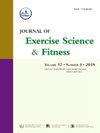美国成年人闲暇时间体育活动模式与表型年龄加速度之间的剂量-反应关系:横截面分析
IF 2.4
2区 医学
Q2 SPORT SCIENCES
引用次数: 0
摘要
目的随着全球人口老龄化的加速,延缓衰老和促进健康老龄化已成为公共卫生和临床医学的焦点。表型年龄加速度(PhenoAgeAccel)是衡量生物衰老速度的重要指标。本研究旨在探讨不同闲暇时间体力活动(LTPA)模式与PhenoAgeAccel之间的关系,分析其关联性和剂量-反应关系。方法本研究利用1999年至2018年美国国家健康与营养调查(NHANES)数据,包括14868名成年人。采用多变量线性回归模型和限制性立方样条法评估LTPA与PhenoAgeAccel之间的关系,并通过分段似然比检验检测非线性阈值。分层回归和交互检验探讨了性别、年龄、种族和社会经济地位对PhenoAgeAccel的潜在影响。结果与没有LTPA的人相比,不活动和定期LTPA模式的人PhenoAgeAccel得分明显较低(P< 0.05),而周末战士模式没有明显影响(P> 0.05)。研究发现了一种非线性阈值效应;每周低强度运动时间低于 560 分钟时,存在明显的负相关(β = -0.001,95 % CI:0.001 至 -0.0003,P < 0.001)。在此阈值之上,LTPA 与 PhenoAgeAccel 呈正相关,表明存在加速衰老的风险(β = 0.0003,95 % CI:0.00002 至 0.001,P = 0.03)。男性和女性都发现了类似的非线性阈值效应。周末战士模式的效果较差。这些发现强调了个性化体育锻炼建议的必要性,并为促进健康老龄化的公共卫生策略提供了证据。本文章由计算机程序翻译,如有差异,请以英文原文为准。
Dose-response relationship between leisure-time physical activity patterns and phenotypic age acceleration in American adults: A cross-sectional analysis
Objectives
With the accelerating global population aging, delaying aging and promoting healthy aging have become focal points in public health and clinical medicine. Phenotypic age acceleration (PhenoAgeAccel) is an important indicator of biological aging speed. This study aims to explore the relationship between different leisure-time physical activity (LTPA) patterns and PhenoAgeAccel, analyzing the association and dose-response relationship.
Methods
This study utilized data from the National Health and Nutrition Examination Survey (NHANES) from 1999 to 2018, including 14,868 adults. Multivariable linear regression models and restricted cubic spline methods were used to assess the relationship between LTPA and PhenoAgeAccel, with segmented likelihood ratio tests to detect non-linear thresholds. Stratified regression and interaction tests explored potential modifications by sex, age, race, and socioeconomic status.
Results
Compared to individuals with no LTPA, those with inactive and regular LTPA patterns had significantly lower PhenoAgeAccel scores (P < 0.05), while the weekend warrior pattern showed no significant effect (P > 0.05). A non-linear threshold effect was found; below 560 min of weekly LTPA, a significant negative correlation existed (β = −0.001, 95 % CI: 0.001 to −0.0003, P < 0.001). Above this threshold, LTPA was positively correlated with PhenoAgeAccel, indicating a risk for accelerated aging (β = 0.0003, 95 % CI: 0.00002 to 0.001, P = 0.03). Similar non-linear threshold effects were found for both males and females.
Conclusion
Regular LTPA significantly reduces phenotypic age acceleration, with a non-linear threshold effect indicating moderate physical activity is most beneficial. The weekend warrior pattern was less effective. These findings highlight the necessity of personalized physical activity recommendations and provide evidence for public health strategies to promote healthy aging.
求助全文
通过发布文献求助,成功后即可免费获取论文全文。
去求助
来源期刊
CiteScore
5.10
自引率
3.60%
发文量
54
审稿时长
31 days
期刊介绍:
The Journal of Exercise Science and Fitness is the official peer-reviewed journal of The Society of Chinese Scholars on Exercise Physiology and Fitness (SCSEPF), the Physical Fitness Association of Hong Kong, China (HKPFA), and the Hong Kong Association of Sports Medicine and Sports Science (HKASMSS). It is published twice a year, in June and December, by Elsevier.
The Journal accepts original investigations, comprehensive reviews, case studies and short communications on current topics in exercise science, physical fitness and physical education.

 求助内容:
求助内容: 应助结果提醒方式:
应助结果提醒方式:


